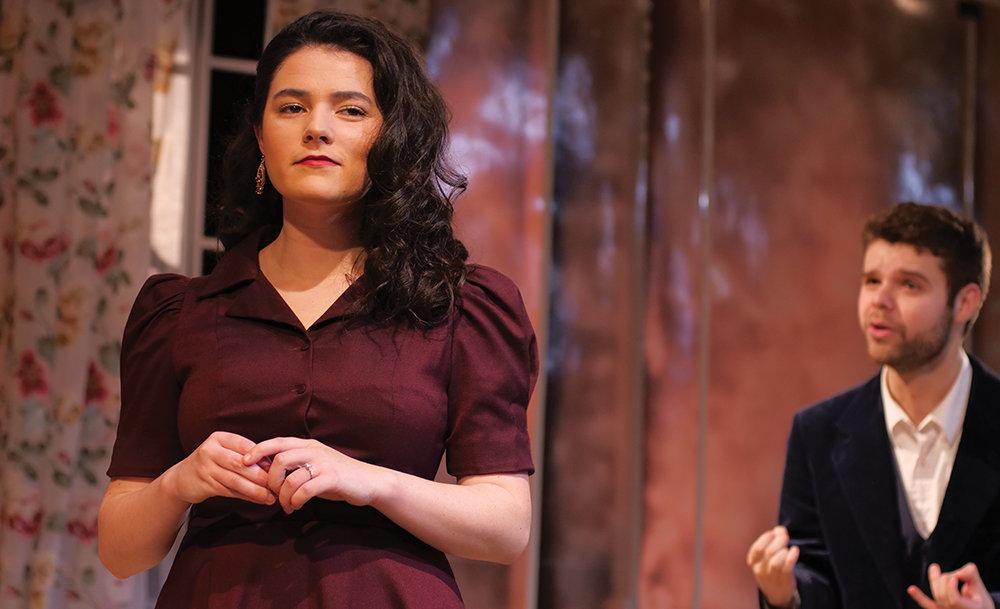Georgetown University’s Mask and Bauble Dramatic Society stuns the audience in its performance of “Hedda Gabler,” a play originally written by Henrik Ibsen in 1891 and more recently adapted for the stage by British playwright Patrick Marber. The play tells the story of a young woman trying to acquire a sense of power and agency in her life despite feeling constrained by different men. Set entirely in a couple’s unfurnished living room, the play manages to demonstrate the everyday struggles of life and how they persist from 1934, when the play is set, to now.
The Mask and Bauble Dramatic Society is enjoying its 168th year, making it the oldest continuously running student theatre group in the country. The play, running until Feb. 22, is directed by Margaret Gleason (COL ’22) and produced by Advait Arun (SFS ’22). (Full disclosure: Arun serves as the cartoonist for The Hoya.) Despite the seven-person performing cast, the play has an extensive team with over forty students on the production and direction staff. From the first few minutes, one can see the nine months of intense effort that went into this production and the collaboration necessary from all members of the play’s cast and staff.
In the effort to tell the story of a woman gaining her agency, “Hedda Gabler” touches on many important ideas to modern life. Addiction, gun violence and mental health are three issues that the main character, Hedda, as well as the other characters in her life struggle with. Due to these issues, the story is not light, and its effect on the audience extends far beyond the time spent in the theater.

Gleason spoke to The Hoya about the relevance of the play’s subject matter to modern society and why she decided “Hedda Gabler” was the play to adapt this semester.
“‘Hedda Gabler’ is wildly relevant to our current era despite having been written over 100 years ago,” Gleason said. “When we have these problems, and we don’t deal with them, and we let our pettiness and our selfishness get in the way of helping others, it brings both us down and the people around us.”
One of the most notable aspects of “Hedda Gabler” is its centering on a woman who possesses power over her body, over men and over her mind. Hedda manipulates everyone, seeking evil at any chance and offering minimal shame committing these acts. While many often depict Hedda as crazy, her lack of agency in the original production shapes her character, according to Gleason.
“Hedda is not given much agency,” Gleason said. “She’s been limited by social expectations of what women should be, feels trapped by a million things so she does what she feels is the only avenue she has for getting any sort of agency or freedom.”
Rarely do plays from this time period represent women with a sense of independence or being equal to men. Yet “Hedda Gabler” does just so. The choice of lighting, stage design and actor placement ensure that the focus of the scene is always on Hedda even when she is not physically there.
Hedda Gabler, played by Meg Edwards, a junior exchange student from the University of Edinburgh, excellently embodies a woman who wants, if not needs, more than she currently has. The scenes where she is alone best encapsulate what Hedda is all about: a woman withholding her power who just needs to scream.
Gleason chose to utilize dance for Hedda’s release of inner rage, one of the few ways in which Gleason added her own personal touch to the script. Throughout the whole process, the focus was keeping the character true to its original depictions while bringing her down to earth for the audience, according to Gleason.
“Something that was important to both me and Meg was humanizing Hedda,” Gleason said. “She’s often depicted just as like the crazy woman, the unhinged woman, and the audience isn’t given any insight into her.”
Gleason and the rest of the Mask and Bauble ensemble certainly accomplished such a goal. Hedda’s strength, masked by the other characters around her, is clear from start to finish. Although Hedda is an 1891 creation, Hedda and her problems still apply in 2020. Mask and Bauble’s “Hedda Gabler” brings the classic story into the modern day while offering evocative performances and powerful storytelling.




















D.M. R. • Feb 17, 2020 at 11:04 am
Ms. Edward’s performance is a tribute to the British theatrical contributions from which the world of theatre has long received benefits.
Well done. Her physical acting as well as her delivery, was outstanding. Georgetown is enriched by her contribution.
Thank you!